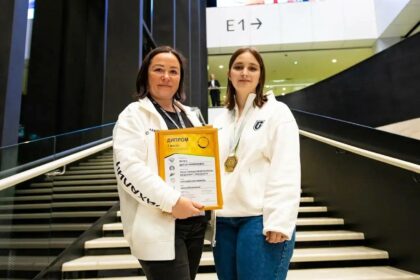Dear Teachers
In this month’s English Page we are looking at vocabulary exercises and I hope that you will find some new ideas here that you would like to try out with your class.
I hope that some of you are experimenting with the Jazz chants from last month’s Page, and trying your hand at writing your own chants as well. Don’t forget that there will be a prize for the best chant – the closing date is 1st December.
Do write to me, Margaret Hay-Campbell, at The British Council, VBGIL, Ulitsa Ulyanovskaya 1, MOSCOW 109189. We really enjoy getting your letters.
The next English Page will be published on Tuesday, 5th December.
**********************************
TEACHING VOCABULARY
At one stage it was common for teachers to tell me that when they started a new unit in the course book they always began with a vocabulary lesson. This meant pre-teaching all the words their students would need to do the unit successfully. The students would be expected to learn all the words by heart for homework before the class started the new unit. We used to discuss other ways of introducing new vocabulary – perhaps by getting the students to work at a short passage in groups, identifying the unfamiliar words and trying to guess the meaning together. Finally, if there were words in the passage which no one in the group knew they were to look them up in the dictionary.
Then, for a while, many teachers did not focus on teaching vocabulary as such – the assumption seemed to be that somehow the students would just “acquire” the vocabulary they needed. There might be lots and lots of new words written up on the board but no real system or interesting activities used to help students to remember them. Now teachers realise that students do need some strategies for learning and remembering vocabulary. Teachers are experimenting with new ways to teach vocabulary and there are some helpful books available in the British Council Resource Centres in Moscow, Nizhny Novgorod, St.Petersburg, and Ekaterinburg. And for those of you who cannot get to a Resource Centre – here are a few ideas you might like to try out with your class.
1. HELPING STUDENTS TO LEARN NEW WORDS – TEACHER-CENTRED ACTIVITIES.
Teachers have always drawn on well-established techniques to introduce new words to students. I am sure you have all used pictures (from magazines and books), drawings (on the blackboard or prepared before the lesson on sheets of paper), real things (apple, book, hat etc.), mime and gesture, and translation (especially where the vocabulary item is abstract). Here are some ideas which you can use to elicit passive vocabulary and then build on that vocabulary to introduce new words. The activities are mainly based around lexical sets as it has been found that we do tend to remember words in sets rather than in isolation.
Brainstorm round a word
Purpose: vocabulary review and extension.
Procedure: Take a word the class has recently learnt, and ask the students to suggest all the words they associate with it. Write each suggestion on the board with a line joining it to the original word, in a circle, so that you get a “sunray” effect. Add further new words to the set. If the origianl word was “clothes” for example, you might get:
As a follow-up, erase everything on the board, expcept for the central word. Challenge your class to recall and write down as many of the brainstormed words as they can. (From “Five Minute Activities” by Ur and Wright).
Spidergrams
Purpose: vocabulary review; to help students organise
new vocabulary.
Procedure: Build up the spidergram on the board (you can see how this is an expansion of the brainstorm activity). You could give the students the spidergram with some of the items blanked out and get them to fill in the spaces (in groups or pairs). The students could also be asked to organise their own diagrams based around the new vocabulary in the unit they are working on.
(From “Working with Words” by Gairns and Redman).
Vocabulary steps
Purpose: Vocabulary review and extension
Procedure: Draw a series of steps on the board. Write “warm” on a middle step. Ask the students to suggest words they could write on the other steps which are warmer or colder than the word “warm”. You can use this idea for all sorts of different sets of gradable adjectives and adverbs eg. awful, bad, so-so, good, excellent OR never, sometimes, often, frequently, always.
(From “Five Minute Activities” by Ur and Wright).
Competitive Dictation
Purpose: Vocabulary review and extension; spelling
Procedure: Have ready for your own use only, a list of the main parts of a car: bonnet, handbrake, headlight, steering wheel, windows, windscreen etc. Draw the minimal outline of a car on two large sheets of paper. Stick these to the walls at either end of the room. Divide the class into two groups, and ask each group to gather round one of the outline cars. Shout out the first item on the list you have prepared. Each team has to write the word on the appropriate part of the car, and draw the item in. Ask the two teams to compare their labelling and spelling. You can use this technique with other objects eg. the outline of a house (roof, door, window, chimney etc.); the classroom (blackboard, desk, bookshelf, flowerpot etc.)
(From “Vocabulary” by Morgan and Rinvolucri).
Categories You will find several exercises in the three books I have used suggesting interesting activities students can do with sorting out words into categories (eg. fruit and vegetables/good and bad personality traits).
2. STUDENT CENTRE ACTIVITIES
These next activities are mainly to be done in groups or else are activities which are personal to the students’ own background and life experience. Research has shown that if new vocabulary is to be learnt and remembered it needs to be used in a meaningful way, with some type of personal involvement. Try out these next two activities and then check in the next lesson as to how many of the new words your students have remembered. You may be surprised!
Preferences
Purpose: To help students learn new vocabulary
through personal involvement.
Procedure: Choose a set of words you want your students to learn and which it is possible for them to express a preference for – eg. vegetables (carrots, peas, potatoes, beetroot, spinach, aubergines); hobbies (swimming, skating, fishing, dressmaking, dancing, singing). Don’t give more than 6 words in the set and check that your students know what each word means by giving a Russian translation before they start on the exercise. Then get them to number the words in order of preference – 1. for the one they like most, 6 for the least prefered activity/food etc. Then they should compare their list with their neighbour and discuss their choices. Check how many words they can remember next lesson.
Priorities
Purpose: (the same as for Preferences).
Procedure: This is a similar activity but done in groups. Give the group the task eg.
– Qualities required for a job:
Put these qualities in order of importance for the jobs given:
QUALITIES: patient/friendly/hard-working/dedicated/studious/
responsible/ imaginative/tactful/flexible
JOBS: doctor/receptionist/actor/diplomat
You must check first that your students know the meanings – give translations of the new, unfamiliar words.
In groups the students do the task and then compare their list with another group.
This activity can be adapted in all sorts of ways – how about choosing from a list of things you would like to take on holiday, or that you would need for a journey to the moon? (From “Ways with Words” by Gairns and Redman.
Life Keywords
Purpose: To encoursge students to expand their
vocabulary by talking about important events in their lives.
Procedure: Ask the students what date it is today. Write it on the board. Ask them what the date was seven years ago. Put that on the board. Ask 3 or 4 people how old they were on that date, seven years ago. Now ask the students to write down ten key emotional or idea words and phrases that sum up their lives now and a further ten to sum up their lives then. When they have drawn up their lists they should pair off and explain the words and why they chose them to their partner.
Here is an example:
NOW: exams, money, future, school, friends, family, pop music
THEN: cat, grandmother, holidays, football, friends, TV etc.
(From “Vocabulary” by Morgan and Rinvolucri)
Asking Others
Purpose: To give students strategies for asking for new words by helping them to describe the context for the word.
Procedure: Pre-teach the structure <> Give the students the worksheet/drawings of household equipment. They should first write down the names of the items they know. They should then mingle and ask each other about any of the items they
don’t know, using the structure practised earlier. Finally you can have a “feedback” session to check that everyone has the correct information.
(From “Working with Words” by Gairns and Redman).
3. STORYTELLING ACTIVITIES
Finally let’s look at two activities where students draw on their vocabulary to tell stories.
Picture stories
There are lots of picture stories available in books in the Resource Centre – or you could draw your own on pieces of paper. Instead of pre-teaching all the vocabulary your students would need to tell the story, try doing one of these activities:
(i) Tell the students they are going to look at a picture story about……..Ask them to form groups to predict the items which are likely to occur. At this stage they may wish to ask you how to say certain things in English. Write their suggestions on the blackboard. At the end, give them the pictures so that they can check which items would be needed.
(ii) Split the class into two groups. Ask one group to predict the vocabulary, as above, and ask the other group to look at the pictures and decide which vocabulary is relevant to the story. At the end, let the groups compare answers.
Co-operative storytelling
A woman was sitting in a cafe drinking tea one afternoon
(describe the woman)
Suddenly a man ran into the restaurant and shouted her name
(what was her name? describe the man)
She looked frightened and went quickly to her bag for….
(what did she want from her bag?)
The man rushed up to her and hit her in the face.
(how did she feel? how did he feel? what happened next?)
Ask students to work in pairs for this activity. Explain they are going to fill in the detailds of a story.
Write the first line of the stoy on the blackboard:
A woman was sitting……
Tell the pairs to describe the woman. Ask them to make brief notes (eg. tall/beautiful/long black hair etc.) Continue with the next line of the story, writing it on the blackboard and giving the students their next instruction, and so on to the end. Now ask each student to find a new partner and tell him his version of the story. Finally, ask one or two students to tell their story to the group. REMEMBER: the students should only be writing a few notes each time, key vocabulary words which they will need for the retelling.
(These two activities are from “Working with Words” by Gairns and Redman).
The activities this month have been taken from “Working with Words” by Gairns and Redman, published by CUP; “Vocabulary” by Morgan and Rinvolucri, published by OUP; “Five Minute Activities” by Ur and Wright, published by CUP. The activities have been reprinted here with kind permission of the publishers.
You can find these books in the British Council Resource Centres.







 Выбор читателей
Выбор читателей







Комментарии